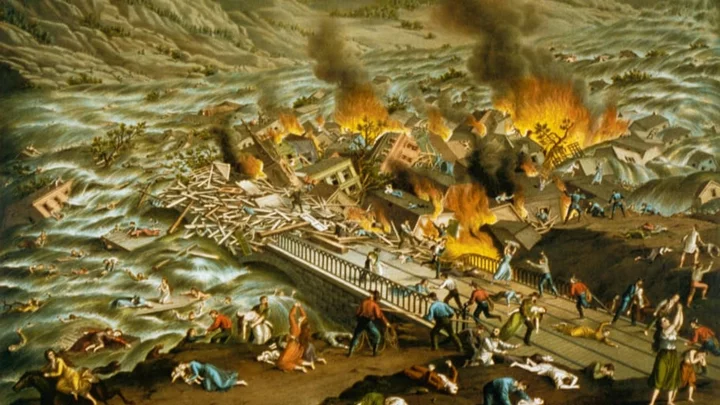Between 3 and 3:15 p.m. on May 31, 1889, the South Fork Dam on Pennsylvania's Little Conemaugh River broke, sending 20 million tons of water from its man-made lake towards the nearby city of Johnstown, Pennsylvania. When the flood reached its outskirts an hour later, there was little its 30,000 residents could do to stop it. The destruction that ensued has been outlined in dozens of history books, and dozens more eyewitness accounts.
But although the Johnstown Flood now holds an almost mythical place in the country’s collective memory, much about the disaster remains shrouded in mystery. How did the dam break in the first place? Who was responsible for this? And why did the dam fail again decades later? The following 10 facts about the Johnstown Flood should answer some of these questions.
1. It was the worst flood in U.S. history.
To this day, the 1889 Johnstown flood remains the worst disaster by dam failure in all of American history. Its official death toll rests at 2209 people, including 99 families and 396 children (though it’s likely some victims were never accounted for). Some 124 women and 198 men were widowed, and over 750 victims buried at the Plot of the Unknown in Johnstown’s Grandview Cemetery were never identified. Some bodies were found as far as Cincinnati, and some were discovered as late as 1911.
The economic damages were just as overwhelming. The flood swept away 1600 homes and caused $17 million in property damages ($550 million when adjusted for inflation). Four square miles of downtown Johnstown was completely destroyed. The “great wave” that hit the city was as tall as 40 feet and as wide as half a mile. Traveling at 40 miles per hour, the water carried debris from other towns in its path, including South Fork, Mineral Point, East Conemaugh, and Woodvale. According to the Johnstown Area Heritage Association, “engineers at the time estimated [the water] moved into the valley with the force of Niagara Falls.” The debris—which at one point caught on fire—spread across an area of 30 acres after the flood waters had gone down.
2. The Johnstown Flood was a product of neglect.
Investigating potential causes, many historians have pointed the finger to the dam’s neglectful administrator, the South Fork Fishing and Hunting Club. A rustic getaway for wealthy businessmen such as Andrew Carnegie, the club acquired the surrounding land from a former congressman, who had in turn acquired it from the Pennsylvania Railroad Company.
The dam had been breached once in 1862—thankfully, the reservoir was nowhere close to full at the time—and was already in poor condition when the country club took over. Ignoring local regulations and administering minimal repairs performed by people who knew nothing about structural engineering, the new management turned the dam into an even bigger flooding hazard than it already was.
Instead of adding height to the dam, they actually lowered the structure to make way for a paved road and then filled the lake to the brim. They installed screens on the spillways—another mechanism used to regulate rainfall—to keep fish from escaping, which trapped debris and kept water from draining. Worst of all, the site’s previous owner had removed and sold the cast-iron discharge pipes that were used to drain the reservoir after heavy rainfall, and the club neglected to replace them—meaning that they couldn’t lower the level of the lake even if they wanted to. When severe thunderstorms and heavy rains hit in the days before the flood, it became a recipe for disaster.
3. Warnings to repair the dam had been ignored.
Fearing for the security of his own businesses, Daniel J. Morrell, a general manager of the Johnstown-based Cambria Iron Company, had sent his own engineers to inspect the dam years before its total failure in 1889. When the engineers came back with bad news, Morrell shared his concerns with the South Fork Fishing and Hunting Club.
Although the initial conversation reached a dead end, Morrell didn’t give up; he joined the country club in the hopes of pushing for renovations from the inside out. His plan might have worked if not for the fact that he died in 1885 at the age of 64. After his death, his membership was transferred to an Iron Company colleague, Cyrus Elder—but their campaign wasn’t successful.
4. The people of Johnstown didn’t believe the dam would fail.
The South Fork Dam failure didn’t go completely unnoticed. On the morning of the disaster, John Parke, an engineer hired by the South Fork Fishing and Hunting Club to inspect their sewage system, tried in vain with a few other men to reinforce the structure and prevent complete failure. At Parke’s behest, the club sent out three telegrams to Johnstown, located about 14 miles away from the reservoir, with the last arriving at 3 p.m.—minutes before the failure. The warnings accomplished little: As dam operator D.M. Montgemery later noted, “nobody paid any more attention to it than if there hadn't been one at all. I know I didn't for one. It seemed like a rumor and they didn’t take any belief in it.” That may have been because, in the words of another person who saw the warnings, reports about the dam’s failure “had been made perhaps nearly every year.”
Later, Johnstown resident Gertrude Quinn Slattery, who was just 6 years old at the time of the flood, recounted what happened after the floodwaters inundated the town. Pulled by the current, she held on to a “raft with a wet muddy mattress and bedding.” Elsewhere, resident Anna Fenn Maxwell was stuck in a room with her seven children as water levels rose. She survived, but her children—and her husband, who had already been washed away—did not.
5. The flood saw the first peacetime disaster relief effort of the Red Cross.
The devastation in Johnstown and the surrounding area spawned a host of relief efforts. The flood was reported in over 100 local newspapers and magazines. What these reports lacked in accuracy, they made up for in efficacy, with readers sending in money, clothing, furniture, and food. Hospitals dispatched doctors armed with medicine and supplies. The town even received lumber for the reconstruction of its buildings.
The biggest relief effort was organized by the American Red Cross, which had been founded in 1881 by nurse Clara Barton. Barton and her team arrived at the scene on June 5 to hand out warm meals and provide medical care. They also set up a number of shelters—called “Red Cross Hotels”—some of which remained in use up until the early 1890s.
6. The South Fork Fishing and Hunting Club claimed the disaster was an “act of god.”
The owners of the South Fork Fishing and Hunting Club were never held responsible for the Johnstown Flood. Several lawsuits were filed, but the club argued that the disaster was an “act of God” that could not possibly have been avoided. Lawsuits against the club were largely unsuccessful because of the influence of its rich and powerful members, but the legal aftermath of the 1889 flood led to the creation of stricter rules to determine liability.
Not only did the country club escape legal culpability, it also didn’t have to pay any compensation to the flood’s many victims, earning its members the ire of Johnstown’s surviving population—and beyond. Per the JAHA website, “The Johnstown Flood became emblematic of what many Americans thought was going wrong with America. In simple terms, many saw the Club members as ‘robber barons’ who had gotten away with murder.” (Though they weren’t held responsible legally, some of the club’s members did choose to contribute to relief efforts afterward.)
Ultimately, the only entity punished in court was the dam’s previous proprietor: the Pennsylvania Railroad Company, which lost two cases dealing with property loss.
7. The club has since become a local boogeyman.
It isn’t clear to what extent the South Fork Fishing and Hunting Club actively contributed to causing the Johnstown Flood; a report by the American Society of Civil Engineers released in 1981 concluded that the dam would have failed regardless of whether or not the club had modified it. Ultimately, the club disbanded in 1904; the law firm that represented it may have discarded many of the club’s documents, and any answers in them, in a move to a new building in 1917, allowing the mystery to persist.
Those who travel to Johnstown and visit the National Memorial there continue to ask about the club’s involvement and culpability. “We’ve had visitors who are normally very mild-mannered suddenly become very excited when the topic of the club is brought up,” National Park Service Ranger Nathan Koozer told The Tribune-Democrat in 2014. “They firmly believe the club members themselves were to blame for all of those deaths.”
8. We continue to learn new things about the Johnstown Flood.
Although the actions of the country club have been widely documented by historians and journalists, we still know surprisingly little about the failure of the dam itself—which components failed first, why they failed, and how. Previously limited by the absence of historical documentation, researchers are now returning to the disaster with the help of digital technology.
In recent years, the University of Pittsburgh-Johnstown has used ground-penetrating radar to analyze the dam site, as well as the speed and volume of the water that hit the city. A new methodology yielded new information: According to a 2015 Times Record article, the research “suggests that the dam had been designed with two spillways to handle periods of heavy rain, but only one was in use.”
9. This wasn’t the last time Johnstown flooded.
After the flood, no federal, state, or county legislation was implemented to prevent a similar disaster from occurring in the future. Consequently, the 1889 Johnstown Flood wasn’t the last time the city was submerged under water. In addition to smaller, seasonal floods that periodically overran streets and basements, two relatively large disasters took place in 1936 and 1977.
The 1936 flood, made possible by heavy snow and rainfall, killed around two dozen people, destroyed 77 buildings, and caused roughly $41 million in property damage. The 1977 flood, a result of severe thunderstorms that caused several dams to fail, killed 85 people while causing $300 million in property damages. Because of its repetitively tumultuous history, Johnstown is now often referred to as “Flood City.”
10. Despite it all, Johnstown is still on the map.
Every disaster following the 1889 flood brought about structural changes to make Johnstown a safer place to live. In 1936, the Works Progress Administration employed workers to dig out the town, clear wreckage, replace sidewalks, and construct bridges. After 1977, the federal government set aside $200 million in aid and grants enabling the victims to build back better.
Thanks to these programs, Johnstown remains inhabited today. The site of the South Fork Dam has since been converted into the Johnstown Flood National Memorial site, which works closely with the Johnstown Flood Museum downtown. The city currently has a population of around 18,000 people, and is home to a branch of the University of Pittsburgh. Fittingly, those visiting Johnstown can find markers around town denoting the water levels for each of the three big floods.
This article was originally published on www.mentalfloss.com as 10 Things You Need to Know About the Johnstown Flood.









